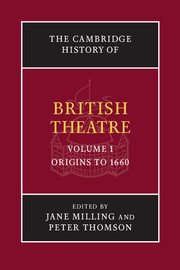Book contents
- Frontmatter
- PART I PRE-ELIZABETHAN THEATRE
- PART II ELIZABETHAN THEATRE
- PART III JACOBEAN AND CAROLINE THEATRE
- 13 Working playwrights, 1580–1642
- 14 Theatre and controversy, 1603–1642
- 15 The Stuart masque and its makers
- 16 Clowns, fools and knaves: stages in the evolution of acting
- 17 Thomas Middleton's A Game at Chess: a case study
- 18 The condition of the theatres in 1642
- 19 Theatre and Commonwealth
- Works Cited
- Index
- References
15 - The Stuart masque and its makers
from PART III - JACOBEAN AND CAROLINE THEATRE
Published online by Cambridge University Press: 28 March 2008
- Frontmatter
- PART I PRE-ELIZABETHAN THEATRE
- PART II ELIZABETHAN THEATRE
- PART III JACOBEAN AND CAROLINE THEATRE
- 13 Working playwrights, 1580–1642
- 14 Theatre and controversy, 1603–1642
- 15 The Stuart masque and its makers
- 16 Clowns, fools and knaves: stages in the evolution of acting
- 17 Thomas Middleton's A Game at Chess: a case study
- 18 The condition of the theatres in 1642
- 19 Theatre and Commonwealth
- Works Cited
- Index
- References
Summary
There is probably no literary genre more elusive of reconstruction, more fugitive of interpretation, yet more significant as a cultural symptom than the court masque. In its fully developed form it lasted only from 1604 to 1640; the scripts that survive (and by no means all of them do) give a very partial sense of the mix of words, music, scene, dance and audience participation that characterised the entertainments. Dismissed by Francis Bacon (in his essay ‘Of masques and triumphs’) as ‘but toys’, and regarded by many outside the court with horror both for their inordinate expense and their supposed encouragement of wantonness, they yet set out to display the magnificence of the court, especially to the foreign ambassadors who competed for invitations, and reported back, with varying degrees of accuracy and enthusiasm, on what they saw. At the same time the techniques of staging and the developments of musical style engendered by these evanescent entertainments were to be of profound significance for theatrical practice in succeeding centuries.
The Stuart masque most often formed a central part of the court's extended Christmas festivities, alongside plays and other entertainments, though they were also performed at other times of the year, and frequently celebrated significant political events – the investiture of Prince Henry as Prince of Wales in 1610, or the marriage of Princess Elizabeth in 1613, for example. The genre was dominated by two figures – Ben Jonson, who provided the words for the majority of Jacobean masques, and Inigo Jones, the designer (appointed Surveyor of the King's Works in 1615).
- Type
- Chapter
- Information
- The Cambridge History of British Theatre , pp. 383 - 406Publisher: Cambridge University PressPrint publication year: 2004
References
- 4
- Cited by



